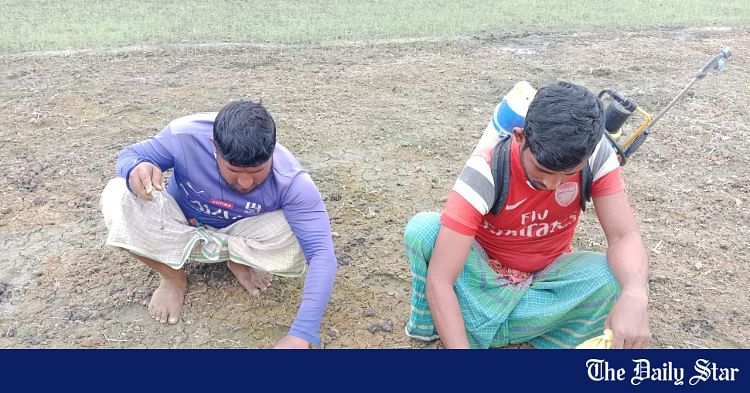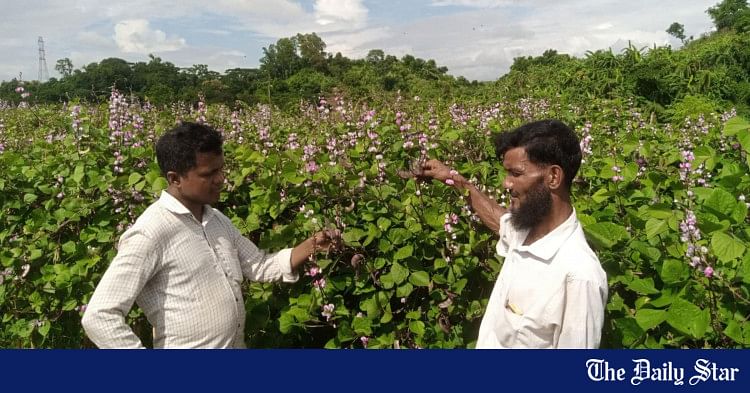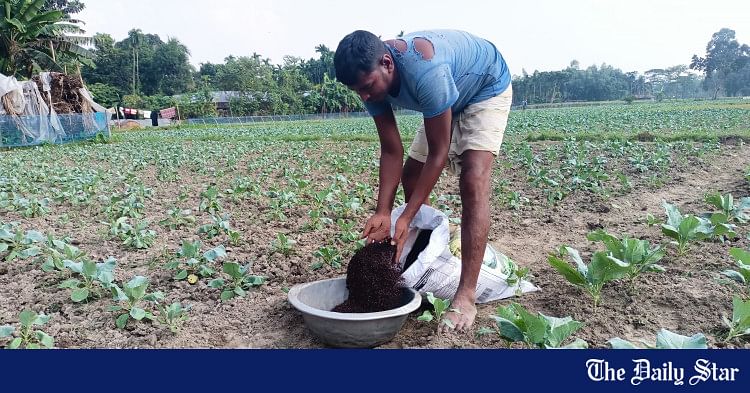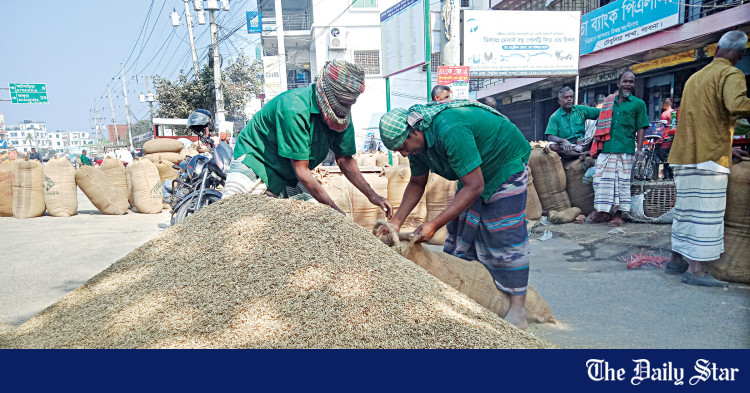Saif
Senior Member
- Joined
- Jan 24, 2024
- Messages
- 15,898
- Likes
- 7,990
- Nation

- Axis Group


Declining arable land: A looming threat to food security
According to the Population and Housing Census 2022 prepared by the Bangladesh Bureau of Statistics (BBS), the total population of the country in an area of 148,460 square kilometres is about 170 million, with a population density of 1,156.84. As high as 68 per cent of them live in rural areas. Tho
Declining arable land: A looming threat to food security
Sarker Nazrul Islam
Published :
Dec 06, 2024 21:43
Updated :
Dec 06, 2024 21:43

According to the Population and Housing Census 2022 prepared by the Bangladesh Bureau of Statistics (BBS), the total population of the country in an area of 148,460 square kilometres is about 170 million, with a population density of 1,156.84. As high as 68 per cent of them live in rural areas. Though BBS has lost much of its credibility due to blatant manipulation of data during the immediate past government led by Sheikh Hasina, it is the only official source of statistics and people have to use them until and unless authentic figures are available. Notwithstanding the discrepancies, the fact remains that Bangladesh, according to the World Population Review, is the ninth most populous country.
The figures relating to areas and population bring us to a horrifying fact that arable land in Bangladesh was reported to be a paltry 0.04789 hectares per head in 2021, according to the World Bank. Even this paltry per capita arable land is gradually decreasing for various reasons including growth of the population at the rate of 1.01 per cent.
An overwhelming majority of the rural population is engaged in and directly or indirectly dependent on agriculture. The secret behind so many people's survival on so scanty arable land is a success story of agriculture over the past decades. But the country was unable to feed 75 million people in the early years of independence due to backward agricultural methods and technologies. Food production has tripled during the past five decades. It has been possible due to extensive agricultural research, innovation of high yielding and stress-tolerant crop varieties including rice and introduction of modern technology in agriculture, albeit on a limited scale. Bangladesh is claimed to have reached almost self-sufficiency in the production of rice, fish and vegetables and is heading towards increased production of milk, meat and fruits. That the contribution of agriculture to the GDP has declined in percentage point compared to industry and the service sector does not mean shrinking of agriculture. It is attributable to the sub-sectors' faster growth following modern development trend.
All this highlights the importance of protecting arable land for the country's food security. Bangladesh is in dire need of preserving and utilising its cultivable land rationally alongside modernising agriculture. But arable land is decreasing at an alarming rate, believed to be by nearly 1.0 per cent due to a lack of effective land zoning system, conversion of cultivable land to non-agricultural use particularly for building homesteads, indiscriminate urbanisation and industrialisation, desertification and land degradation, and construction of roads and embankments. Salinity intrusion along the entire coastline is one of the major reasons behind the decline in arable land. Moreover, extreme weather pattern, courtesy of global warming, at times adversely impacts productivity of whatever meagre cultivable land people have. Another cause for concern is that productivity of high yielding crop verities seems to be fast reaching a saturation point, beyond which the law of diminishing return starts operating. Introduction of genetically modified crops could be a viable option to increase production but without knowing definitely the consequences of shifting to those, it is unwise to make an option for GM crops. These grim realities are a threat to people's food security in the near future.
When the horizontal expansion of villages is one of the major causes behind the conversion of farmland to non-farm use, land zoning project could discourage the use of farmland for homestead and other purposes but it seems to be still in its infancy.
Unplanned and unrestricted use of farm and forest land for industrialisation and haphazard expansion of urban area have led to loss of cultivable land. Due to salinity intrusion, about 17 per cent of the country's total land area has already become unfit for crop, vegetable and fruit production. Desertification process in certain areas and land degradation also lead to loss of much needed cultivable land. Time is approaching fast when arable land will make an insignificant percentage of the country's total area. In that case, Bangladesh will have to be a predominantly import-dependent country to fulfil its food demand.
Overall, preservation of the remaining arable land and reclamation of the lost areas are a dire necessity to ensure food security for the population. It seems to be the hardest ever job given the level of sincerity and efficiency of the administration and awareness of the land users. Vertical expansion of villages could stop the loss of farm land, provided that the country has the policy planning and adequate resources to opt for upward (and downward) expansion of villages. Bangladesh does not have a magic lamp to do that. It is easy to talk about 'turning every village into a town' but it is one of the hardest tasks to accomplish. Planned urbanisation and industrialisation could help stop the process of arable land loss but there seems to be none to bell the cat, as past experience suggests.
Preservation of arable lands is not an isolated issue integral only to livelihood of the rural populace, it is interlinked to the national economy. The loss of cultivable land, therefore, demands greater attention for a comprehensive solution to the problem. It is an unrelenting process that takes its toll silently but over a period it exposes its deleterious impacts. Hence, there is the urgency to arrest it sooner than later.
Sarker Nazrul Islam
Published :
Dec 06, 2024 21:43
Updated :
Dec 06, 2024 21:43
According to the Population and Housing Census 2022 prepared by the Bangladesh Bureau of Statistics (BBS), the total population of the country in an area of 148,460 square kilometres is about 170 million, with a population density of 1,156.84. As high as 68 per cent of them live in rural areas. Though BBS has lost much of its credibility due to blatant manipulation of data during the immediate past government led by Sheikh Hasina, it is the only official source of statistics and people have to use them until and unless authentic figures are available. Notwithstanding the discrepancies, the fact remains that Bangladesh, according to the World Population Review, is the ninth most populous country.
The figures relating to areas and population bring us to a horrifying fact that arable land in Bangladesh was reported to be a paltry 0.04789 hectares per head in 2021, according to the World Bank. Even this paltry per capita arable land is gradually decreasing for various reasons including growth of the population at the rate of 1.01 per cent.
An overwhelming majority of the rural population is engaged in and directly or indirectly dependent on agriculture. The secret behind so many people's survival on so scanty arable land is a success story of agriculture over the past decades. But the country was unable to feed 75 million people in the early years of independence due to backward agricultural methods and technologies. Food production has tripled during the past five decades. It has been possible due to extensive agricultural research, innovation of high yielding and stress-tolerant crop varieties including rice and introduction of modern technology in agriculture, albeit on a limited scale. Bangladesh is claimed to have reached almost self-sufficiency in the production of rice, fish and vegetables and is heading towards increased production of milk, meat and fruits. That the contribution of agriculture to the GDP has declined in percentage point compared to industry and the service sector does not mean shrinking of agriculture. It is attributable to the sub-sectors' faster growth following modern development trend.
All this highlights the importance of protecting arable land for the country's food security. Bangladesh is in dire need of preserving and utilising its cultivable land rationally alongside modernising agriculture. But arable land is decreasing at an alarming rate, believed to be by nearly 1.0 per cent due to a lack of effective land zoning system, conversion of cultivable land to non-agricultural use particularly for building homesteads, indiscriminate urbanisation and industrialisation, desertification and land degradation, and construction of roads and embankments. Salinity intrusion along the entire coastline is one of the major reasons behind the decline in arable land. Moreover, extreme weather pattern, courtesy of global warming, at times adversely impacts productivity of whatever meagre cultivable land people have. Another cause for concern is that productivity of high yielding crop verities seems to be fast reaching a saturation point, beyond which the law of diminishing return starts operating. Introduction of genetically modified crops could be a viable option to increase production but without knowing definitely the consequences of shifting to those, it is unwise to make an option for GM crops. These grim realities are a threat to people's food security in the near future.
When the horizontal expansion of villages is one of the major causes behind the conversion of farmland to non-farm use, land zoning project could discourage the use of farmland for homestead and other purposes but it seems to be still in its infancy.
Unplanned and unrestricted use of farm and forest land for industrialisation and haphazard expansion of urban area have led to loss of cultivable land. Due to salinity intrusion, about 17 per cent of the country's total land area has already become unfit for crop, vegetable and fruit production. Desertification process in certain areas and land degradation also lead to loss of much needed cultivable land. Time is approaching fast when arable land will make an insignificant percentage of the country's total area. In that case, Bangladesh will have to be a predominantly import-dependent country to fulfil its food demand.
Overall, preservation of the remaining arable land and reclamation of the lost areas are a dire necessity to ensure food security for the population. It seems to be the hardest ever job given the level of sincerity and efficiency of the administration and awareness of the land users. Vertical expansion of villages could stop the loss of farm land, provided that the country has the policy planning and adequate resources to opt for upward (and downward) expansion of villages. Bangladesh does not have a magic lamp to do that. It is easy to talk about 'turning every village into a town' but it is one of the hardest tasks to accomplish. Planned urbanisation and industrialisation could help stop the process of arable land loss but there seems to be none to bell the cat, as past experience suggests.
Preservation of arable lands is not an isolated issue integral only to livelihood of the rural populace, it is interlinked to the national economy. The loss of cultivable land, therefore, demands greater attention for a comprehensive solution to the problem. It is an unrelenting process that takes its toll silently but over a period it exposes its deleterious impacts. Hence, there is the urgency to arrest it sooner than later.










































